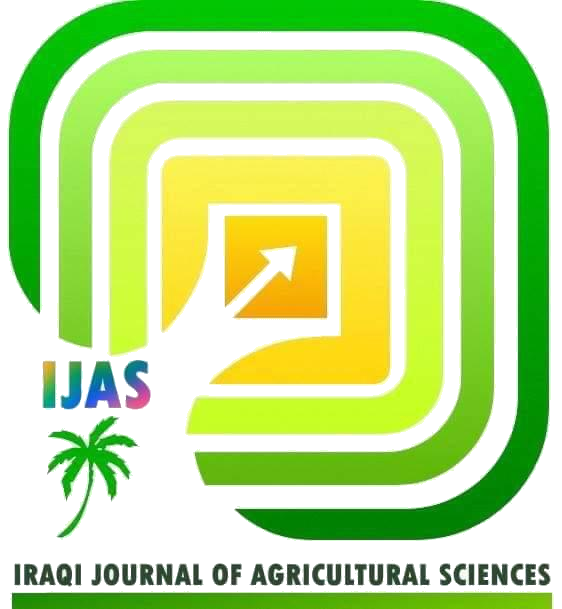CLONING AND EXPRESSION OF DNAK GENE ISOLATED FROM LOCAL ISOLATE OF E. COLI RU-3 IN BL21 CELL
DOI:
https://doi.org/10.36103/s0kx0747Keywords:
HSP70; isopropyl-β-D-thiogalactopyranoside; IPTG; recombinant protein.Abstract
A set of 60 samples were collected from different sources of multiple areas of Hyderabad (India) in order to select a local Escherichia coli isolates that have the ability to produce HSP70. 26 isolates were characterized after studied the morphological characteristics and microscopic properties of the isolates on macConkey agar and EMB recorded after 24hr. and grams staining was done. The isolated bacteria were screened for various biochemical tests to get 11 isolates that submitted for molecular identification, and the amplification of 16S rRNA regions using universal primer (16S rDNA) verified only 5 E. coli isolates which were sequenced and NCBI accession numbers were acquired. Five distinct isolates (RU-1, RU-3, RW-1, RS-4, and RF-3) of the gene dnaK and its surrounding area were successfully amplified in order to isolate the dnak gene, which encodes the DnaK protein. Amplicons' nearly identical sequences were discovered by restriction fragment length polymorphism (RFLP). The dnak gene from one representative, RU-3 isolate with accession number OL741466 isolated from Urine samples from suspected urinary tract infection (UTI) patients of Sir Ronald Ross Institute of Tropical and Communicable Diseases Nallakunta, Hyderabad, India was successfully cloned and sequenced by overlapping using 3 set of primers. The 1850 bp long dnaK gene encodes a polypeptide of 607 residues of amino acids. Using pBAD TOPO TA expression systems, the dnaK gene of RU-3 was cloned and expressed in E. coli BL21 (DE3). Incubating the BL21 with different concentrations of isopropyl-β-D-thiogalactopyranoside (IPTG) allowed the grown E. coli to determine the optimum concentration which was 0.05mM to induce the production of recombinant HSP70 protein within 5 hr. which considered as the best expression time in this study.
References
1. Ajulo, H.O, M.O. Ajulo, and N.U. Ekereumoh, 2020. Isolation and identification of Salmonella and E. coli from raw goat meat in Uyo Metropolis, Akwaibom state. Asian Food Science Journal, 50-60.
2. Abdullah, T., J. M. Rutz, S. P. Singh, V. I. Kalve, and P. E. Klebba, 1991. Evolution of the ferric enterobactin receptor in gram-negative bacteria. Journal of bacteriology, 173(19), 5964-5974. https://doi.org/10.1128/jb.173.19.5964-5974.1991
3. Angelom D, T. James Peeler, and E. Gary Rodrick. 1995. Effect of oxytetracycline-medicated feed on antibiotic resistance of gram-negative bacteria in catfish ponds. Applied and environmental microbiology, 61(6), 2335-2340. https://doi.org/10.1128/aem.61.6.2335-2340.1995
4. Bogado P., M. Hostens, P. Sys, P. Vercauteren, and G. Opsomer, 2017. Cytological endometritis at artificial insemination in dairy cows: Prevalence and effect on pregnancy outcome, Journal of Dairy Science, Volume 100, Issue 1, Pages 588-597,
5. Bossi F.N., R. Balbontín, and L. Bossi. 2022. Preparing plasmid DNA from bacteria. Cold Spring Harbor Protocols, 2022(10), pdb-prot107852.
6. De Oliveira A. N, L. A. de Oliveira, J. S. Andrade, and J.A.F. Chagas. 2007. Rhizobia amylase production using various starchy substances as carbon substrates. Braz. J. Microbiol. 38: 208-216
7. Farrar, J., P. Hotez, T. Junghanss, G. Kang, D. Lalloo, and N.J. White. 2013. Manson's Tropical Diseases E-Book. (23rd ed.). Oxford: Elsevier health sciences.
8. Fellahi, S., M.E. Harrak, J.H. Kuhn, et al. 2016. Comparison of SYBR green I real-time RT-PCR with conventional agarose gel-based RT-PCR for the diagnosis of infectious bronchitis virus infection in chickens in Morocco. BMC Res Notes 9, 231.
9. Gabe, C.M., S.J. Brookes, and J. Kirkham 2017. Preparative SDS PAGE as an Alternative to His-Tag Purification of Recombinant Amelogenin. Frontiers in physiology, 8,424.
10. Green M.R. and J. Sambrook. 2020. ‘’The Inoue Method for Preparation and Transformation of Competent E. coli: “Ultracompetent” Cells Cold Spring Harbor Laboratory Press pp:210.
11. Hameed, S.S., A. H. Ulaiwi, and S.M. Hamad. 2022. Diagnosis of E.coli isolated from arthritis in chickens by VITEK and molecular methods. Iraqi Journal of Agricultural Sciences, 53(1), 141-146. https://doi.org/10.36103/ijas.v53i1.1518
12. Hwang, J., L.M. Mattei, L.G. VanArendonk, P.M. Meneely, and I.N. Okeke. 2010. A pathoadaptive deletion in an enteroaggregative Escherichia coli outbreak strain enhances virulence in a Caenorhabditis elegans model. Infection and immunity, 78(9), 4068–4076.
13. Kapli, P., Z. Yang, and M.J. Telford, 2020. Phylogenetic tree building in the genomic age. Nature Reviews Genetics, 21(7), 428-444.
14. Karim, S. J. I., M. Islam, T. Sikder, R. Rubaya, J. Halder, and J. Alam. 2020. Multidrug-resistant Escherichia coli and Salmonella spp. isolated from pigeons. Veterinary world, 13(10), 2156.
15. Kumar, S., G. L. Stecher, C. Knyaz, and K. Tamura. 2018. MEGA X: molecular evolutionary genetics analysis across computing platforms. Molecular biology and Evolution, 35(6), 1547.
16. Lü, R., D. Yang, Z. Feng, Y. Li, and G. Zhang, 2024. Cloning and functional analysis of heat shock protein Hsp70 from Sclerotinia sclerotiorum. Sheng wu gong cheng xue bao= Chinese journal of Biotechnology, 40(10), 3677-3688.
17. Liang, W., X. Wang, M. Lin, and L. Lin, 2009. A 70-kDa molecular chaperone, DnaK, from the industrial bacterium Bacillus licheniformis: gene cloning, purification and molecular characterization of the recombinant protein. Indian J. Microbiol. 49, 151–160
18. Macošek Jakub, Mas Guillaume, Hiller Sebastian 2021. Redefining Molecular Chaperones as Chaotropes.Frontiers in Molecular Biosciences. vol8
19. Mahadeo Mandal, M., S. Mehdi, and P.K. Mishra. 2022. Evaluation of bacterial profile and antimicrobial susceptibility pattern for urinary tract infection in prefnancy. Int J Acad Med Pharm, 4(4), 235-237.
20. Maksum I. P, F. P. U. Latifah, A. Nabiel, N. F. Lestari, S. Sriwidodo, M. I. Azizah, et al. 2023. An Overview of Culture Conditions for Recombinant Protein Expression in Escherichia coli. J Appl Biotechnol Rep.2023;10(1):864-75. doi:10.30491/JABR.2022.349844.1547
21. Miao, Z. Q., Y. Q. Tu, P. Y. Guo, W. He, T. X. Jing, J. J. Wang, and D. D. Wei, 2020. Antioxidant Enzymes and Heat Shock Protein Genes from Liposcelis bostrychophila Are Involved in Stress Defense upon Heat Shock. Insects, 11(12), 839.
22. Mital, S., Christie, G. and Dikicioglu, D. 2021. Recombinant expression of insoluble enzymes in Escherichia coli: a systematic review of experimental design and its manufacturing implications. Microb Cell Fact 20, 208.
23. Mühlmann, M., E. Forsten, S. Noack, and J. Büchs. 2017. Optimizing recombinant protein expression via automated induction profiling in microtiter plates at different temperatures. Microbial cell factories, 16(1), 1-12.
24. Murugan Kumar, Radha Prasanna, Showkat Lone, Jasdeep Chatrath Padaria, Anil Kumar Saxena 2014. Cloning and expression of dnaK gene from Bacillus pumilus of hot water spring origin. Applied & Translational Genomics, Vol3, Issue 1, Pages 14-20,
25. Ono K, T. Hibino, T. Kohinata, S. Suzuki, Y. Tanaka, T. Nakamura, and T. Takabe. 2001. Overexpression of DnaK from halotolerant C. Aphanothece halophytica enhances the high-temperature tolerance of tobacco during germination and early growth. Plant Sci. 160, 455-461
26. Rao, J. Venkateshwara. 2019. Insilico characterization, phylogenetic analysis and homology based 3d structural modeling of hspa4 heat shock protein family a (Hsp70) Member 4 from Homo Sapiens (Human). International Journal of Engineering and Advanced Technology. 9. 3086-3091.
27. Riggs A. D. 2021. Making, Cloning, and the Expression of Human Insulin Genes in Bacteria: The Path to Humulin. Endocrine reviews, 42(3), 374–380.
28. Saadi Al-Baer, A., and A.A. Hussein. 2017. Isolation and Identification of Escherichia coli Producing Cytosine Deaminase from Iraqi patients. Int. J. Adv. Res. Biol. Sci, 4(11), 1-6.
29. Sambrook J, and D. W. Russell. 2001. Molecular Cloning: a Laboratory Manual.3rd edn. New York: Cold Spring Harbor Laboratory Press
30. Singh, V.K., S. Utaida, L.S. Jackson, R.K. Jayaswal, B.J. Wilkinson, and N.R. Chamberlain. 2007. Role for dnaK locus in tolerance of multiple stresses in Staphylococcus aureus. Microbiology 153, 3162–3173.
31. Tabar, R. H., E. Ghavanloo, and S.A. Fazelzadeh.2016. Nonlocal continuum-based modeling of mechanical characteristics of nanoscopic structures. Physics Reports, 638, 1-97.
32. Tu, Z., L. Tang, M. H. Abo-Raya, M. Sun, H. Shen, and Y. Wang, 2024. Cloning and characterization of heat shock transcription factor 1 and its functional role for Hsp70 production in the sea slug Onchidium reevesii. Gene, 893, 147945.
33. Wetzstein, M., U. Volker, J. Dedio, F. Lobau, U. Zuber, M. Schiesswohl, C. Herget, M. Hecker, and W. Schumann. 1992. Cloning, sequencing, and molecular analysis of the dnaK Locus from Bacillus subtilis. J. Bacteriol. 174, 3300–3310
34. Zhang, J., Hu, Y., Feng, J., He, N., Li, X., Liyi, Q., ... and Yang, W. 2025. Hsp70-mediated manipulation of antimicrobial peptide-related genes promotes BmNPV proliferation in Bombyx mori at relatively high temperatures. International Journal of Biological Macromolecules, 143426.
35. Zhang, J., J. Huang, C. Fang, W. Li, H. Zhao, F. Kong, and Q. Wang, 2022. Molecular cloning of heat shock protein 60 (Sp HSP60) from Schizothorax prenanti and the gene expressions of four Sp HSPs during lipopolysa ccharide (LPS) infection. fishes, 7(3), 139.
Downloads
Published
Issue
Section
License
Copyright (c) 2025 IRAQI JOURNAL OF AGRICULTURAL SCIENCES

This work is licensed under a Creative Commons Attribution-NonCommercial 4.0 International License.

2.jpg)


